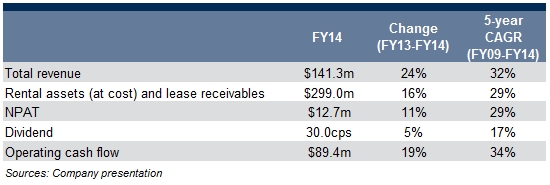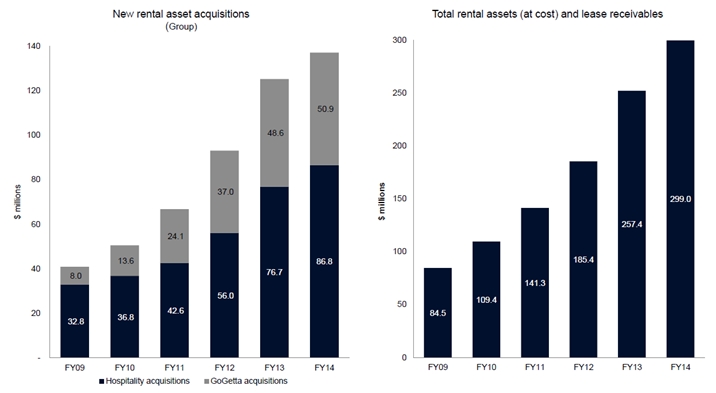by
Ekaterina Skulskaya | Aug 26, 2014
Key points:
1. Silver Chef Limited (Silver Chef) reported 11.0% growth in net profit after tax for FY14 to $12.7m, despite a 14.7% fall in the pre tax profit of its GoGetta business.
2. The company continued to grow, acquiring $50.9m of rental assets in the GoGetta division and $86.8m in the hospitality division, taking total rental assets to $299m.
3. GoGetta's pre-tax profit fell by 14.7% to $9.3m. Management undertook an extensive review of the business and cited that the business “had a strong last quarter and the business overall has good growth prospects for the year ahead”.
On Monday Silver Chef Limited (Silver Chef) reported its FY14 results, headlined by an increase of 24% in the total revenue for the year ended 30 June 2014 to $141.3m and a record net profit after tax of $12.7m, up 11% from the previous year (see Table 1).
Silver Chef Rentals (Hospitality) revenue grew 26% from $76.6m to $96.7m, where $93.1m was generated in Australia with the balance coming from New Zealand and Canada. GoGetta Equipment Funding (GoGetta) contributed $9.3m in pre-tax profit, down from $10.9m in the FY13. Despite the fall of 14.7% in Go Getta pre-tax profit, management undertook an extensive review of the business and cited that the business “had a strong last quarter and the business overall has good growth prospects for the year ahead”.
The growth in rental revenues came from the Hospitality business (17% since 30 June 2013) but was partially offset by weaker growth than expected in the GoGetta brands which was flagged earlier to the market. Overall, growth in the GoGetta rental asset base and lease receivables was slower than in previous years, increasing by 15% since 30 June 2013.

Table1
The full investor presentation can be viewed here
Key figures from the announcement included:
- EBITDA increased 20.8% from $72.1m in FY13 to $87.1m. Margins decreased slightly on the back of the expansion into Canada for the Hospitality business and the establishment of a second service facility in Melbourne. The impact of establishing the Canadian business in the 2014 financial year is a pre-tax net loss of $1.3m; the start up loss on Melbourne facility was $0.9m
- EBIT increased 6% to $24.9m versus $23.4m in FY13
- NPAT increased 29% to $12.7m
- Operating cashflows were up 19% to $89.4m. Net operating cashflow was affected by an increase in receipts from customers in the form of rental payments and security bonds, offset by an increase in amounts paid to suppliers and employees
- Bad debt expense increased from $652,000 to $1.6m but is still considered relatively minor
- Total debt increased by $17.3m from $92.2m at the 30 June 2013 to $109.5m at the 30 June 2014
- CBA debt facility was increased from $110m to $120m during the year, bringing total debt facilities including the unsecured corporate notes ($30m) to $150m, with $40.5m undrawn
Asset growth
Total rental assets (at cost) increased 16% to $299m versus $257.4m in FY13. The company acquired $50.9m of rental assets in the GoGetta division, while Hospitality acquisitions were up 13% to $86.8m ($76.7m in FY13). The strong growth of assets over the past six years is depicted in the charts below.

Source: Company reports
Figure 1
Overall, this was a very good result from Silver Chef with solid growth in revenue and NPAT, albeit at lower levels than in the past.
From a relative value perspective, the Silver Chef 8.5% fixed rate bonds with a maturity date of 14 September 2018 (callable at $103 on 14 September 2015, $102 on 14 September 2016 or $101 on 14 September 2017) are considered fairly priced when compared to other FIIG originated deals, having traded in from a credit margin at issue of 475bps to be indicatively offered at a margin of circa 320bps. That equates to a current offer price of $107.75 and yield to maturity of 6.30%, however, should the company decide to call prior to maturity that would reduce the expected return.